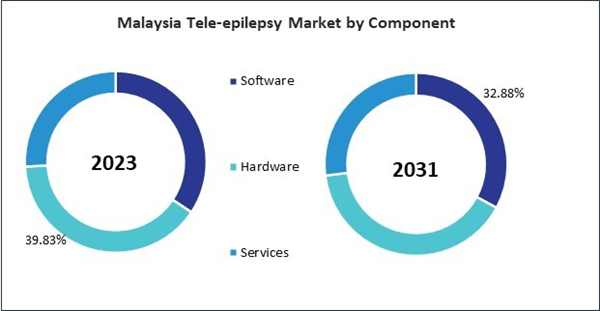The Asia Pacific Tele-epilepsy Market is expected to witness market growth of 16.1% CAGR during the forecast period (2024-2031).
The China market dominated the Asia Pacific Tele-epilepsy Market by Country in 2023, and is expected to continue to be a dominant market till 2031; thereby, achieving a market value of $99.7 million by 2031. The Japan market is registering witness a CAGR of 15.5% during 2024-2031. Additionally, the India market would witness a CAGR of 17% during 2024-2031.
The market has witnessed substantial growth due to advancements in wearable technology and data analytics, which have enhanced the ability of healthcare providers to monitor patient’s conditions continuously. Wearable devices, such as EEG headsets and seizure-detecting wristbands, enable real-time monitoring and data collection that can be transmitted directly to healthcare providers. This capability is a game-changer for epilepsy care, allowing specialists to track seizure patterns, frequency, and severity outside of a clinical setting.
For patients, these devices provide a sense of security and allow them to lead more independent lives, as they no longer have to rely solely on periodic clinical visits to assess their condition. The data collected from these devices can inform treatment adjustments and even predict seizure occurrences, helping both patients and providers manage epilepsy more proactively.
Southeast Asian countries like the Philippines focus on tele-epilepsy to bridge healthcare disparities across islands and rural areas. The Philippines’ Department of Health has launched the Universal Health Care Act, which includes provisions for telemedicine to reach patients with limited access to specialists. Government-backed initiatives like “eHealth Philippines” are promoting tele-epilepsy by providing funding for digital health projects and partnering with local healthcare providers to establish telemedicine clinics in remote areas. The government’s emphasis on building telemedicine capacity in rural and underserved regions is positioning tele-epilepsy as a practical solution for neurological care, gradually improving healthcare equity nationwide. As a result, the region has become a key player in the market.
The China market dominated the Asia Pacific Tele-epilepsy Market by Country in 2023, and is expected to continue to be a dominant market till 2031; thereby, achieving a market value of $99.7 million by 2031. The Japan market is registering witness a CAGR of 15.5% during 2024-2031. Additionally, the India market would witness a CAGR of 17% during 2024-2031.
The market has witnessed substantial growth due to advancements in wearable technology and data analytics, which have enhanced the ability of healthcare providers to monitor patient’s conditions continuously. Wearable devices, such as EEG headsets and seizure-detecting wristbands, enable real-time monitoring and data collection that can be transmitted directly to healthcare providers. This capability is a game-changer for epilepsy care, allowing specialists to track seizure patterns, frequency, and severity outside of a clinical setting.
For patients, these devices provide a sense of security and allow them to lead more independent lives, as they no longer have to rely solely on periodic clinical visits to assess their condition. The data collected from these devices can inform treatment adjustments and even predict seizure occurrences, helping both patients and providers manage epilepsy more proactively.
Southeast Asian countries like the Philippines focus on tele-epilepsy to bridge healthcare disparities across islands and rural areas. The Philippines’ Department of Health has launched the Universal Health Care Act, which includes provisions for telemedicine to reach patients with limited access to specialists. Government-backed initiatives like “eHealth Philippines” are promoting tele-epilepsy by providing funding for digital health projects and partnering with local healthcare providers to establish telemedicine clinics in remote areas. The government’s emphasis on building telemedicine capacity in rural and underserved regions is positioning tele-epilepsy as a practical solution for neurological care, gradually improving healthcare equity nationwide. As a result, the region has become a key player in the market.
List of Key Companies Profiled
- Shimmer Research Ltd.
- Emotiv Inc.
- CortiCare, Inc.
- SEVARO
- Tele Specialists
- Real Time Tele-Epilepsy Consultants
- ScienceSoft USA Corporation
- Zeto, Inc.
- TeleEEG
- Epitel, Inc.
Market Report Segmentation
By Patient
- Adult
- Pediatric
By End Use
- Healthcare Consumers
- Hospitals Providers
- Payers
By Component
- Software
- Hardware
- Services
By Country
- China
- Japan
- India
- South Korea
- Australia
- Malaysia
- Rest of Asia Pacific
Table of Contents
Chapter 1. Market Scope & Methodology
Chapter 2. Market at a Glance
Chapter 3. Market Overview
Chapter 4. Asia Pacific Tele-epilepsy Market by Patient
Chapter 5. Asia Pacific Tele-epilepsy Market by End Use
Chapter 6. Asia Pacific Tele-epilepsy Market by Component
Chapter 7. Asia Pacific Tele-epilepsy Market by Country
Chapter 8. Company Profiles
Companies Mentioned
- Shimmer Research Ltd.
- Emotiv Inc.
- CortiCare, Inc.
- SEVARO
- Tele Specialists
- Real Time Tele-Epilepsy Consultants
- ScienceSoft USA Corporation
- Zeto, Inc.
- TeleEEG
- Epitel, Inc.
Methodology

LOADING...









